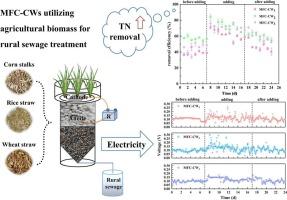Study on the treatment of rural sewage with microbial fuel cell-constructed wetlands enhanced by agricultural biomass
IF 6.3
2区 工程技术
Q1 ENGINEERING, CHEMICAL
引用次数: 0
Abstract
In response to the low carbon-to‑nitrogen ratio of rural sewage after biological treatment, corn stalks, wheat straw, and rice straw were selected as additional carbon sources for the microbial fuel cell-constructed wetlands (MFC-CWs). Carbon release of the biomass was not improved obviously by NaOH pretreatment, and the removal efficiency of nitrate nitrogen from pretreated wheat straw (94.8 %) was only slightly higher than that of unpretreated straw (91.6 %). Therefore, to avoid secondary pollution caused by pretreatment, original corn stalks, wheat straw and rice straw were used as carbon sources for MFC-CWs. The concentration of chemical oxygen demand in effluent did not change obviously with the carbon sources addition, but the total nitrogen removal rates in MFC-CWs with corn stalks, wheat straw, and rice straw addition of 70 g/m2 increased by 22.72 %, 16.17 % and 26.14 %, respectively. Additionally, the average output voltage increased by 12.19–33.19 mV with carbon sources addition, while the electricity generation decreased by 0.22–0.65 mW/m2 after the carbon sources were removed. With the addition of biomass, abundant microorganisms associated with denitrification (Cyanobacteria and unclassified_f__Rhodobacteraceae), electricity generation (Acidobacteriota and Proteobacteria), and organic matter degradation (Chloroflexi, Actinobacteriota, and Bacteroidota) were observed in MFC-CWs. Therefore, the use of agricultural biomass to enhance the performance of MFC-CWs is a promising method for treating rural sewage.

利用微生物燃料电池构建的湿地处理农业生物质农村污水的研究
针对农村生活污水经生物处理后碳氮比低的问题,选择玉米秸秆、小麦秸秆和水稻秸秆作为微生物燃料电池构建湿地(MFC-CWs)的补充碳源。经 NaOH 预处理后,生物质的碳释放并没有得到明显改善,预处理后的小麦秸秆对硝酸盐氮的去除率(94.8%)仅略高于未经处理的秸秆(91.6%)。因此,为了避免预处理造成的二次污染,原玉米秆、小麦秸秆和水稻秸秆被用作 MFC-CW 的碳源。出水的化学需氧量浓度并没有随着碳源的添加而发生明显变化,但玉米秸秆、小麦秸秆和水稻秸秆添加量为 70 g/m2 的 MFC-CW 的总氮去除率分别提高了 22.72%、16.17% 和 26.14%。此外,添加碳源后,平均输出电压增加了 12.19-33.19 mV,而去除碳源后,发电量减少了 0.22-0.65 mW/m2。随着生物质的加入,在 MFC-CWs 中观察到了大量与反硝化(蓝藻和未分类的__F__Rhodobacteraceae)、发电(酸性杆菌和蛋白质细菌)和有机物降解(Chloroflexi、放线菌和类杆菌)相关的微生物。因此,利用农业生物质来提高 MFC-CWs 的性能是一种处理农村污水的可行方法。
本文章由计算机程序翻译,如有差异,请以英文原文为准。
求助全文
约1分钟内获得全文
求助全文
来源期刊

Journal of water process engineering
Biochemistry, Genetics and Molecular Biology-Biotechnology
CiteScore
10.70
自引率
8.60%
发文量
846
审稿时长
24 days
期刊介绍:
The Journal of Water Process Engineering aims to publish refereed, high-quality research papers with significant novelty and impact in all areas of the engineering of water and wastewater processing . Papers on advanced and novel treatment processes and technologies are particularly welcome. The Journal considers papers in areas such as nanotechnology and biotechnology applications in water, novel oxidation and separation processes, membrane processes (except those for desalination) , catalytic processes for the removal of water contaminants, sustainable processes, water reuse and recycling, water use and wastewater minimization, integrated/hybrid technology, process modeling of water treatment and novel treatment processes. Submissions on the subject of adsorbents, including standard measurements of adsorption kinetics and equilibrium will only be considered if there is a genuine case for novelty and contribution, for example highly novel, sustainable adsorbents and their use: papers on activated carbon-type materials derived from natural matter, or surfactant-modified clays and related minerals, would not fulfil this criterion. The Journal particularly welcomes contributions involving environmentally, economically and socially sustainable technology for water treatment, including those which are energy-efficient, with minimal or no chemical consumption, and capable of water recycling and reuse that minimizes the direct disposal of wastewater to the aquatic environment. Papers that describe novel ideas for solving issues related to water quality and availability are also welcome, as are those that show the transfer of techniques from other disciplines. The Journal will consider papers dealing with processes for various water matrices including drinking water (except desalination), domestic, urban and industrial wastewaters, in addition to their residues. It is expected that the journal will be of particular relevance to chemical and process engineers working in the field. The Journal welcomes Full Text papers, Short Communications, State-of-the-Art Reviews and Letters to Editors and Case Studies
 求助内容:
求助内容: 应助结果提醒方式:
应助结果提醒方式:


